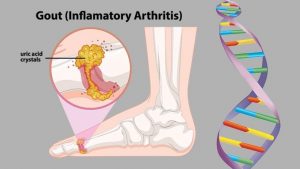Gout ?
 Gout is a form of arthritis which starts as a result of excess uric acid build-up in the blood, also called hyperuricemia. It is an extremely painful condition. Uric acid is produced in the body during the breakdown of purines – chemical compounds that are found in certain foods such as meat, poultry, and seafood. Normally, uric acid is dissolved in the blood and is excreted from the body in the urine via the kidneys. If too much uric acid is produced, it can build up and form needle-like crystals that trigger inflammation and pain in the joints and surrounding tissue. The condition often starts by affecting the joint at the base of the big toe. Attacks often occur without warning and in the middle of the night. They can come on quickly and keep returning over time, slowly damaging tissues in the region of the inflammation.
Gout is a form of arthritis which starts as a result of excess uric acid build-up in the blood, also called hyperuricemia. It is an extremely painful condition. Uric acid is produced in the body during the breakdown of purines – chemical compounds that are found in certain foods such as meat, poultry, and seafood. Normally, uric acid is dissolved in the blood and is excreted from the body in the urine via the kidneys. If too much uric acid is produced, it can build up and form needle-like crystals that trigger inflammation and pain in the joints and surrounding tissue. The condition often starts by affecting the joint at the base of the big toe. Attacks often occur without warning and in the middle of the night. They can come on quickly and keep returning over time, slowly damaging tissues in the region of the inflammation.
Tests and diagnosis
Gout can be tricky to diagnose, as it’s symptoms can be similar to those of other conditions, i.e. bunion on the big toe. While hyperuricemia occurs in the majority of people that develop gout, it may not be present during a flare. There is one very subtle, important difference between gout and other foot conditions, that helps the health practitioner differentiate between them. When you very gently stroke the skin of a gout affected area, it will cause a lot of pain in the sufferer. This does not occur with other conditions. The gout makes the skin super sensitive. This test is not 100% accurate, but I have found it to be a reasonably good indicator that one should look in the direction of gout, and refer the patient onto a doctor. This is especially true, if during examination and history take, the patient meets other criteria that would make them more prone to gout, and there has been no specific injury to the area affected. Often with tests you are more trying to rule out other conditions and narrow your possibilities down to that of gout..
One diagnostic test that doctors can carry out is the joint fluid test, where fluid is extracted from the affected joint with a needle. The fluid is then examined to see if any urate crystals are present. As joint infections can also cause similar symptoms to gout, a doctor can also look for bacteria when carrying out a joint fluid test in order to rule out a bacterial cause. Doctors can also do a blood test to measure the levels of uric acid in the blood. However, people with high uric acid levels do not always experience gout. Equally, some people can develop the symptoms without having increased levels of uric acid in the blood. Finally, doctors can search for urate crystals around joints or within a tophus(deposit of uric acid crystals) using ultrasound or CT scans. X-rays cannot detect gout, but may be used to rule out other causes.
Treatment
Treatment and control of the condition requires certain dietary modifications such as reducing the intake of foods high in purines ie. red meat, shellfish, and beer to name but a few. Other factors that contribute to gout include being overweight, certain medications, high blood pressure, drinking too many sugary sodas, and being regularly dehydrated. These all need to be monitored and corrected.
Treatments for acute attacks include:
- NSAIDs – Non-Steroidal Anti-Inflammatory Drugs
- Colchicine
- Steroids
- Urate-Lowering Therapy (ULT)
For more see video
Overview by physiotherapists in Tralee, Co. Kerry